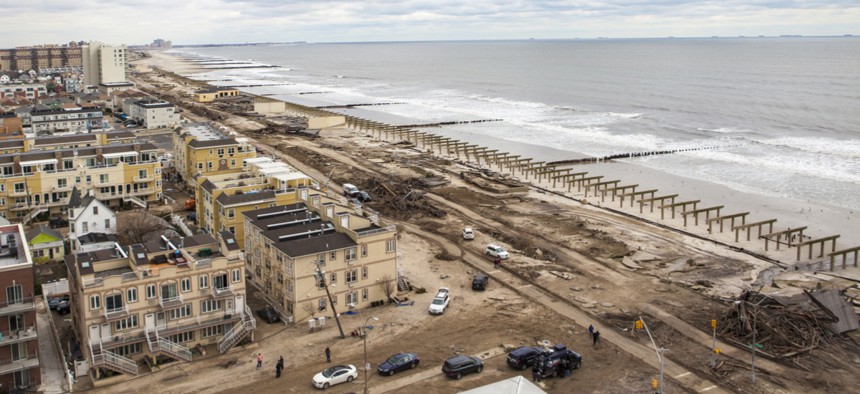The White House Doesn’t Think Sea Level Rise Is Important to U.S. Infrastructure

In New York City, Far Rockaway, Queens, was flooded by Hurricane Sandy in 2012. Shutterstock
“It’s deeply fiscally irresponsible to put taxpayer funded facilities at risk like that,” according to Michael Gerrard, director of Columbia University’s Sabin Center for Climate Change Law.
The latest climate change rule on President Trump’s chopping block: preparing for a rise in sea level.
Trump will sign an executive order Tuesday (Aug 15) that rescinds an Obama-era order requiring government agencies to take into account future sea-level rise when building federal infrastructure.
The intent is to “streamline the current process” for infrastructure permits, one official told Reuters. But experts say the move is likely to result in more federal spending on disaster relief and infrastructure repairs down the line.
Obama’s order required federal agencies take into account the “best-available science” on sea-level rise when designing new buildings and public works, and to elevate infrastructure in flood-risk areas by two feet above the height a major flood in that area might reach. More critical infrastructure, like hospitals, would need to be elevated three feet.
The National Association of Home Builders were among the groups that balked at the order, saying it would raise construction costs. But revoking it would be “a fiscally irresponsible decision that is a disaster for taxpayers,” Eli Lehrer, president of the R Street Institute, a conservative think tank that advocates for free-market solutions to climate change, told Bloomberg.
Many expected Trump to nix the flood-resilience order back in March, when he issued his first climate change executive order. According to an E&E News reporter, the rollback was in the draft of that order, but was cut at the last moment, perhaps after pushback from experts.
“I think they will meet a lot of resistance from agencies that will have to live with these facilities for decades to come,” Michael Gerrard, director of Columbia University’s Sabin Center for Climate Change Law, told me in March. “The Navy, by definition, has nothing but coastal facilities. Some of them already have water lapping up on their shores.”
He’s right. A 2016 report from the Union of Concerned Scientists found that three feet of sea- level rise—an amount NASA considers inevitable—threatens to submerge 128 military bases by 2100.
At Norfolk Naval Base in Virginia, an uptick in flooding has already caused officials to shut off electricity supplies to docks during high-water events. The National Oceanic and Atmospheric Administration has recorded 15 inches of sea-level rise in that area since 1927—the most extreme sea-level rise on the East Coast, according to North Carolina Public Radio.
“The administration can revoke federal orders but they can’t revoke the laws of physics,” Gerrard said. “It’s deeply fiscally irresponsible to put taxpayer funded facilities at risk like that.”
Zöe Schlanger is an environment reporter for Quartz, where this article was originally published.
NEXT STORY: Why Trump’s ‘Buy American’ Push Puts Alaska in Tough Spot





